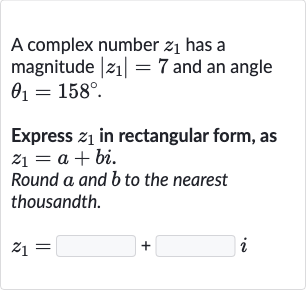Full solution
Q. A complex number has a magnitude and an angle .Express in rectangular form, as .Round and to the nearest thousandth.
- Convert to Radians: To convert a complex number from polar to rectangular form, we use the formulas and , where is the magnitude and is the angle in radians.
- Calculate Real Part: First, we need to convert the angle from degrees to radians because the trigonometric functions in most calculators use radians. The conversion is done by multiplying the angle in degrees by . in radians = .
- Calculate Imaginary Part: Now we calculate the real part of the complex number using the cosine function.
- Perform Calculations: Next, we calculate the imaginary part of the complex number using the sine function.
- Round to Nearest Thousandth: Perform the calculations for and using a calculator.
- Round to Nearest Thousandth: Perform the calculations for and using a calculator.Round and to the nearest thousandth. rounded to rounded to
More problems from Compare linear and exponential growth
QuestionGet tutor help
QuestionGet tutor help
QuestionGet tutor help
QuestionGet tutor help
QuestionGet tutor help
QuestionGet tutor help
QuestionGet tutor help

